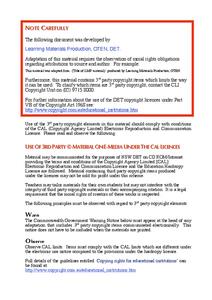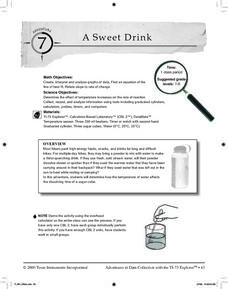Teach Engineering
Pill Dissolving Demo
Plop, plop, fizz, fizz, oh that one is the fastest. The teacher demonstration is the second part of a four-part series. The class observes how different pill types dissolve in simulated stomach acid. They determine which one dissolves...
It's About Time
Volcanos and the Atmosphere
In the summer of 1815, snow fell every month in New England. Was this related to the volcanic eruption of Tambora in Indonesia earlier in the year? Young scientists design their own experiments to research the long-term effect a volcanic...
Millennium Schools
Lifestyle Chemistry
My name is Bond, Hydrogen Bond. Written for distance scholars working on chemistry at the high school level, the lesson includes eight weeks worth of material divided into six parts: substances you use, mixing it up, your skin, what's...
National Science Teacher Association
Middle School Sampler: Science
Focus on inquiry-based learning in your science class with a series of activities designed for middle schoolers. A helpful packet samples four different texts, which include activities about predator-prey relationships, Earth's axis...
Curated OER
"I'm Melting!"
Third and fourth graders engage with a worksheet designed to help them differentiate between melting and dissolving. After reading an informative paragraph about the two actions, they consider four scenarios, and choose whether they...
Curated OER
Observation Milk Fat Lesson
Turn your class loose to experiment with the different fat content in skim milk, whole milk, half and half, and heavy cream. This is a visually vibrant experiment, as learners drip food coloring on the surface of the products and measure...
American Chemical Society
Colors Collide or Combine?
As part of a unit investigating the dissolving of M&Ms® candy coating, this activity examines whether or not the different colors combine. There are no new concepts revealed in this particular activity, but learners will see that the...
Curated OER
Sugar in Tea
Little chemists address whether or not you can get sugar back out of tea after it has dissolved. The PowerPoint itself simply walks them through the questioning process, considering different possibilities. The final slide settles on...
Curated OER
A Sweet Drink
Students investigate reaction rates. In this seventh or eighth grade mathematics lesson, students collect, record, and analyze data regarding how the temperature of water affects the dissolving time of a sugar cube. Studetns...
Curated OER
Mixing Dissolving Quiz
Answer true or false to get through this 11 question quiz on mixing and dissolving. Budding chemists who know their stuff will have no problem determining which dissolving and mixing questions are correct. A basic quiz on the basic...
Curated OER
Mixtures
In this chemistry worksheet, students use the clues given at the bottom of the sheet to complete the crossword puzzle on mixtures. There are 18 clues to solve on the sheet.
Curated OER
Polymerization Experiments
Students study the concepts of polymerization and the function of crosslinkage. For this polymer lesson students complete a lab activity and write down their observations.
Curated OER
Solubility Lab
In this solubility worksheet, students test a variety of polar and non polar substances to determine which ones will dissolve in vegetable oil and which ones will dissolve in water. Students collect data and answer 2 questions about...
Curated OER
Dissolving Solids and Gases
In this dissolving solids and gases worksheet, students learn that the process of dissolving gas is opposite of the process of dissolving solids. Students answer 3 critical thinking questions about dissolving gases and solids in solutions.
Curated OER
Solubility Curves
In this solubility worksheet, learners use a solubility curve to determine is different solutions are saturated or not. This worksheet has 19 problems to solve and 2 short answer questions.
Curated OER
The Effect of Temperature on Solubility
In this solubility activity, students conduct an experiment to see how temperature effects the solubility of salt in water. Students record their data in a chart and then graph the results. Then students complete 2 short answer questions.
Curated OER
A Tasty Solution
In this solutions worksheet, students complete a three step procedure and record the dissolving time of candy. Using their data they create a graph and answer 4 analysis questions.
Curated OER
Water - the (Nearly) Universal Solvent
In this solvent worksheet, students explore why water is considered a universal solvent. Students explore what can change dissolving rates. This worksheet has 8 matching, 3 short answer, 11 fill in the blank, and 4 problems to solve.
Curated OER
The Formation of Solutions
In this solutions worksheet, students compare situations that increase or decrease the solubility of a solute. Students describe how surface area, stirring, and temperature can increase the rate of dissolving a solute. This worksheet has...
Curated OER
Solids and Water
Pupils investigate mixtures made of water and familiar solid materials. They observe and discuss the changes that occur immediately and set the mixtures aside for a day. Finally, students observe the mixtures, note changes, and graph the...
Curated OER
Colligative Properties Worksheet
In this solutions worksheet, students determine the boiling points and melting points of solutions. Students calculate the effective molality of a solute. This worksheet has five problems to solve.
Curated OER
What Happens When You Mix Things?
In this mixtures worksheet, students complete 3 statements about what happens when you mix things together. This worksheet is a graphic organizer.
Curated OER
How Does Matter Change?
For this matter worksheet, students will fill in the blank of 3 statements that show facts about the changes that can happen to matter. Students will then fill in the blank of 1 conclusion statement.
Curated OER
What Properties Do Solutions Have?
In this solutions worksheet, students will write down two properties that solutions have and then will come up with a conclusion about solutions based on their facts.

























